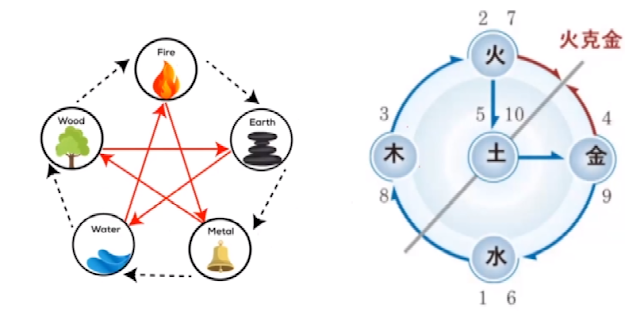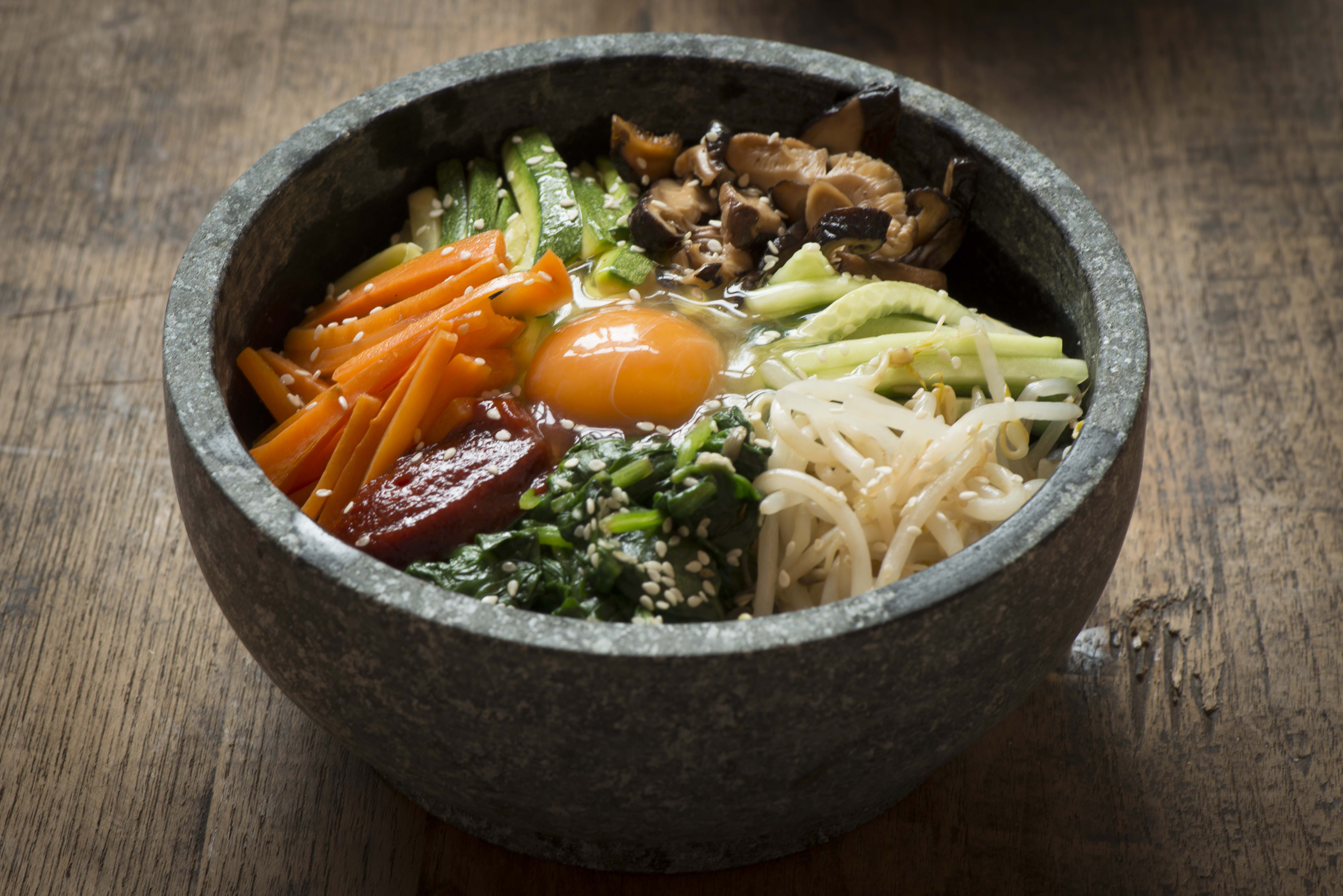YIN AND YANG (PART-2)
YIN AND YANG (PART-2)
Yin and yang becomes the law of the five elements
 |
| Cycle of elements |
1. Wood: Energy that brings life to humanity and all life -> Birth (Yang)
2. Fire : Energy of dispersion and growth in all life -> Growth (Yang)
3. Earth: Energy that governs and harmonizes the elements (Meditator)
4. Metal: Energy that brings maturity and unity to all life-> Harvest (Yin)
5. Water: Energy that halts all cosmic activity and puts all life to rest (Yin)
 |
| Five Element in each category |
 |
| The life bettering cycle and the restraining cycle of the Five Elements |
Hado, Nakseo, and the life cycle of the five elements

The term do-seo-gwan(library, bibliotheca) is a term used to refer to a place that preserved this knowledge and teachings.
The White and Black dots are due to the origin of Yin and Yang.
Unknown facts of the Nakseo
 The Magic square is originated by the help of Nakseo, so the magic square is actually a nine tile equation, like in whichever direction you want to calculate the output always comes out to be 15. The knowledge of this was given by the Dangun Wanggeom (the 1st ruler of Gojoseon) to the "Emperor Woo". The essence of this knowledge came from ancient Korea.
The Magic square is originated by the help of Nakseo, so the magic square is actually a nine tile equation, like in whichever direction you want to calculate the output always comes out to be 15. The knowledge of this was given by the Dangun Wanggeom (the 1st ruler of Gojoseon) to the "Emperor Woo". The essence of this knowledge came from ancient Korea.
Taeho Bokhee, the founder of the Eastern Philosophy
The last son of the 5th Heavenly Emperor, Tae-woo-ui Hwanung of Baedal Dynasty. Drew the Hado diagram from the divination shown on the back of an enormous horse(known as 'dragon horse'). Yin and Yang and the Five Elements come from the Hado. He is the founder of the eight trigrams which became part of South Korean National flag. The eight trigrams represent the phenomenon in the nature.
 The Magic square is originated by the help of Nakseo, so the magic square is actually a nine tile equation, like in whichever direction you want to calculate the output always comes out to be 15. The knowledge of this was given by the Dangun Wanggeom (the 1st ruler of Gojoseon) to the "Emperor Woo". The essence of this knowledge came from ancient Korea.
The Magic square is originated by the help of Nakseo, so the magic square is actually a nine tile equation, like in whichever direction you want to calculate the output always comes out to be 15. The knowledge of this was given by the Dangun Wanggeom (the 1st ruler of Gojoseon) to the "Emperor Woo". The essence of this knowledge came from ancient Korea.Taeho Bokhee, the founder of the Eastern Philosophy
 |
| Taeho Bokhee |
Yin and Yang in real lives of Korean people

Bibimbap
• Five Flavors
Spiciness - Metal - Gochujang
Bitterness - Fire - Greens
Sour and Saltiness - Wood and Water - Soy sauce
Sweetness - Earth – Rice
• Five Colors
Green/blue, Red, Yellow, White, Black
Five Colors used in stripes for male and female costumes were known as Saekdong, and it supposedly gave great spiritual power and blessings to those who wore them. Many Korean traditional shamans wore clothes that contained all five colors.
Yin and Yang and Korean Alphabet(hangul)

Vowels are divided in yin and yang. And the consonants are divided in to the five elements.
Hun min jeong um
King Sejong brought together the Hun min jeong um (The guide of book on how to pronounce the new language "Korean". In this he talks about that how everything is basically in Yin and Yang.
전지의 도는 한번 응하고 한번 양하며 오행의 이치를 생성할 뿐이라. 곤괘와 복과 사이가 태극이 되고 동정이 있은 뒤에 음과 양이 되니라. 무릇 어떤 생물이든 하늘과 땅 사이에 있는 것들이 음양을 버리고 어디로 가리오. 그러므로 사람의 말소리에 다 음양의 이치가 있는데도 다만 사람들이 살피지 않았을 뿐이라. 이제 정음을 지음에 처음부터 지혜로 경영하고 힘써 찾은 것이 아니라 다만 그 말소리로 인하여 그 이치를 다했을 뿐이라. 이치가 이미 둘이 아니니, 어찌 천지와 귀신과 더불어 그 쓰임을 같이 하지 않으리오 정음 28자도 각각 그 형상을 본떠서 만들 였음이라.
TRANSLATION_
... Where would all things between the heaven and earth would go without yin and yang? So, even with the everyday sounds, lie the principles of yin and yang but people have yet to figure out. Now that we created the right pronunciation not based on wisdom to manage from the start but based on the sounds of spoken words. Since the cosmic principle is not two but one, the principles within Hangeul are the same with the ones within heaven, earth, and the spirit realm.
Yin and Yang in the Korean royal palace

Five Elements in the Royal Palace and Seoul City
 |
| Heung-in-ji-mun(East), Don-ui-mun(West), Soong-rye- mun(South), Suk-jeong-mun(North) |
 |
| Geonchoon-mun(East), Gwanghwa-mun(South), Youngchu-mun (West), Sinmu-mun(North) |
The five elements were also shown in the 2018 Winter Olympics and also in k-drama "The Legend".
Five Elements evolves in to the 10 heavenly stems and 12 earthly branches.
Conclusion
Korean people traditionally believed that humans came from the heavens, the stars, and that's where all humans eventually return to.
This is the very reason why Koreans abided by the cosmic laws, the natural laws of the universe, and incorporated the cosmic principles in every aspect of their daily lives. (For ex. you abide by the law of your city, state, and country.
This is the very reason why Koreans abided by the cosmic laws, the natural laws of the universe, and incorporated the cosmic principles in every aspect of their daily lives. (For ex. you abide by the law of your city, state, and country.
We are all cosmic beings! 🌍
Koreans believed that all humans are cosmic beings that came from the stars and return to the stars after death. In essence, we are all children of heaven and earth. We come from heaven and earth and we return to heaven and earth. This is why the universe is known as macro- universe(macro-cosmos), and human beings are known as micro-universe(micro-cosmos).
The practice of becoming one with heaven and earth was known as cultivating the dao. And those who becomes one with heaven and earth attains enlightenment. And people of 'Hahn' as Koreans refer to themselves in Korean language means "those who have attained the light of heaven and earth within them.
The practice of becoming one with heaven and earth was known as cultivating the dao. And those who becomes one with heaven and earth attains enlightenment. And people of 'Hahn' as Koreans refer to themselves in Korean language means "those who have attained the light of heaven and earth within them.
 This is a small part of the knowledge which Mr. Kim Sean provided to all the people joining the online seminar of season 1 of HACD.
This is a small part of the knowledge which Mr. Kim Sean provided to all the people joining the online seminar of season 1 of HACD.Sources:-
Five elements in royal palace- https://www.chosun.com/site/data/html_dir/2012/03/12/2012031203301.html
Gyeonbok palace- https://travel.usnews.com/images/gettyimages-516351649_rQXknmO.jpg
Bibimbap - https://upload.wikimedia.org/wikipedia/commons/4/44/Dolsot-bibimbap.jpg
HACD Hallyu Archetypal Culture Delegation
 HACD is a non-profit organization that has been providing free online sessions and making efforts to promote Korea's lost history and culture to the world. Moreover, it aims to shed light on the hidden common roots of cultures and histories worldwide, not just limited to Korea. Through this, we hope that you will become future talents by acquiring cultural competence that others cannot read.
HACD is a non-profit organization that has been providing free online sessions and making efforts to promote Korea's lost history and culture to the world. Moreover, it aims to shed light on the hidden common roots of cultures and histories worldwide, not just limited to Korea. Through this, we hope that you will become future talents by acquiring cultural competence that others cannot read.
 We recruit new members around December each year and operate on a seasonal basis. We are currently in Season 3. In Season 3, we are functioning as a journalist team, where participants creatively produce new content based on what they have learned from the previous season. Additionally, we have regular general meetings once a month. In the upcoming journalist team gathering, small rewards will be given to those who excel in article writing, and all participants will receive a mobile certificate of completion.
We recruit new members around December each year and operate on a seasonal basis. We are currently in Season 3. In Season 3, we are functioning as a journalist team, where participants creatively produce new content based on what they have learned from the previous season. Additionally, we have regular general meetings once a month. In the upcoming journalist team gathering, small rewards will be given to those who excel in article writing, and all participants will receive a mobile certificate of completion.
In the previous Seasons 1 and 2, we had weekly meetings. Each member had their assigned mentors. HACD is also is the university division of the Daehan Sarang corporation.
If you want to discover the true driving force behind Hallyu, which has moved the hearts of people around the world, I highly recommend joining HACD!
Bibimbap - https://upload.wikimedia.org/wikipedia/commons/4/44/Dolsot-bibimbap.jpg
HACD Hallyu Archetypal Culture Delegation
 HACD is a non-profit organization that has been providing free online sessions and making efforts to promote Korea's lost history and culture to the world. Moreover, it aims to shed light on the hidden common roots of cultures and histories worldwide, not just limited to Korea. Through this, we hope that you will become future talents by acquiring cultural competence that others cannot read.
HACD is a non-profit organization that has been providing free online sessions and making efforts to promote Korea's lost history and culture to the world. Moreover, it aims to shed light on the hidden common roots of cultures and histories worldwide, not just limited to Korea. Through this, we hope that you will become future talents by acquiring cultural competence that others cannot read. We recruit new members around December each year and operate on a seasonal basis. We are currently in Season 3. In Season 3, we are functioning as a journalist team, where participants creatively produce new content based on what they have learned from the previous season. Additionally, we have regular general meetings once a month. In the upcoming journalist team gathering, small rewards will be given to those who excel in article writing, and all participants will receive a mobile certificate of completion.
We recruit new members around December each year and operate on a seasonal basis. We are currently in Season 3. In Season 3, we are functioning as a journalist team, where participants creatively produce new content based on what they have learned from the previous season. Additionally, we have regular general meetings once a month. In the upcoming journalist team gathering, small rewards will be given to those who excel in article writing, and all participants will receive a mobile certificate of completion.In the previous Seasons 1 and 2, we had weekly meetings. Each member had their assigned mentors. HACD is also is the university division of the Daehan Sarang corporation.
If you want to discover the true driving force behind Hallyu, which has moved the hearts of people around the world, I highly recommend joining HACD!
Instagram: https://www.instagram.com/hacd.official/
Youtube: https://www.youtube.com/@hansadan

INSTAGRAM:
HACD English - https://www.instagram.com/hacd.official/
HACD Korean - https://www.instagram.com/hansadan.official/
YOUTUBE:
HACD YouTube - m.youtube.com/@hansadan









댓글
댓글 쓰기